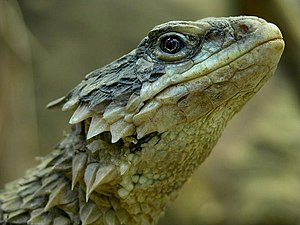Giant belt tail
| Giant belt tail | ||||||||||||
|---|---|---|---|---|---|---|---|---|---|---|---|---|

Giant Belt Tail ( Smaug giganteus ) |
||||||||||||
| Systematics | ||||||||||||
|
||||||||||||
| Scientific name | ||||||||||||
| Smaug giganteus | ||||||||||||
| ( Smith , 1844) |
The giant girdle tail ( Smaug giganteus , Syn . : Cordylus giganteus ) is the largest species of the girdle tail family (Cordylidae). It occurs in South Africa in the central and eastern Free State , in the southern Transvaal and northeast KwaZulu-Natal . It is listed as endangered ( vulnerable ) on the IUCN's Red List of Endangered Species .
features
Giant belt tails are strongly built lizards with a dorsoventrally flattened body and a total length of up to 40 cm. The scales are large, keeled and thorn-like, especially those that sit whorled on the tail. The large head is triangular and has a wreath of conspicuously large scales on the rear edge. The back is medium to dark brown in color, the belly is yellow-brown. The throat and mouth are yellow. The males have enlarged, glandular-looking scales above the femoral pores and enlarged scales on the underside of the forelimbs.
Way of life
Giant belt tails are active for about eight months from late spring to autumn and spend the winter in their earthworks in hibernation . These are created in colonies in the grasslands, and more rarely in rocky scrubland, with each animal creating its own unbranched passage that can run several meters through the ground at a depth of about 30 cm. The diurnal animals often sunbathe on termite burrows . Various invertebrates serve as food, mainly beetles . When threatened, the animals kick their prickly tails and try to escape into their burrows. If this does not succeed, they pretend to be dead with their armored backs turned towards the attacker.
The females give birth to one to three live cubs every other year in late summer (January to February) .
swell
- Günther Nietzke: The terrarium animals 3 . 4th edition. Eugen Ulmer GmbH & Co., Stuttgart 2002, ISBN 3-8001-7459-6 , p. 231-232 .
Individual evidence
- ↑ Smaug giganteus in the IUCN 2008 Red List (English)
- ↑ a b J.H. van Vyk: Seasonal variation in stomach contents and diet composition in the large girdled lizard, Cordylus giganteus (Reptilia: Cordylidae) in the Highveld grasslands of the northeastern Free State, South Africa . In: African Zoology . tape 35 , no. 1 , 2000, pp. 9-19 ( online ).
- ^ JH van Wyk: Physiological Changes during the Female Reproductive Cycle of the Viviparous Lizard cordylus giganteus (Sauria: Cordylidae) . In: Herpetologica . tape 50 , no. 4 , 1994, pp. 480-493 .
